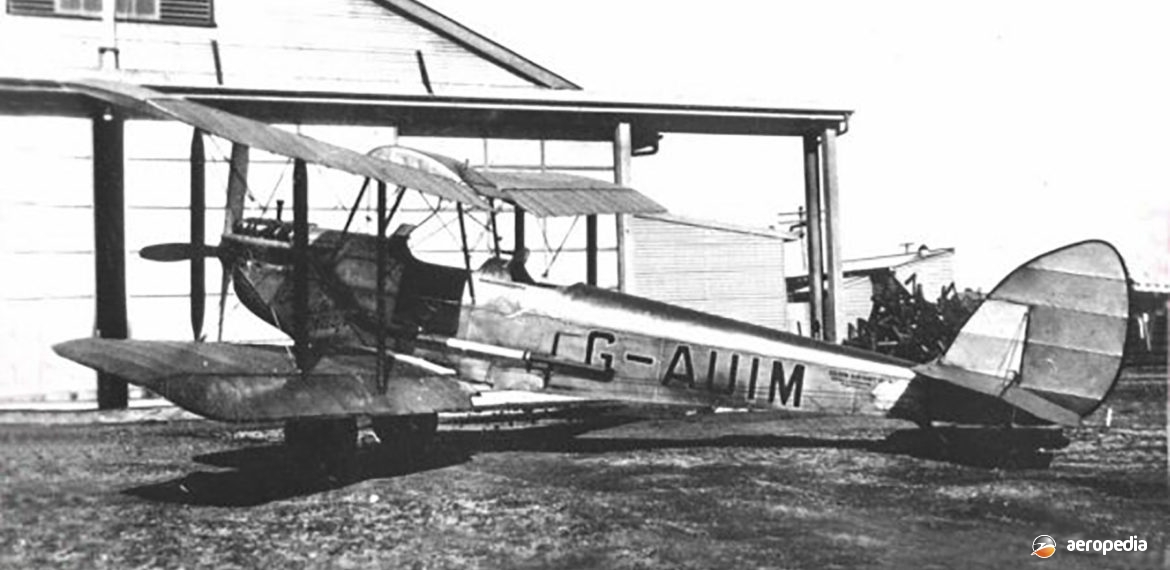Photograph:
de Havilland DH.51 G-AUIM (c/n 100) operated by Bunny Hammond in 1927 (Frank Walters collection)
Country of origin:
United Kingdom
Description:
Light touring and sport biplane
Power Plant:
One 67 kw (90 hp) RAF 1A eight-cylinder VEE air-cooled engine
Specifications:
- Wingspan: 11.27 m (37 ft)
- Length: 8.07 m (26 ft 6 in)
- Wing area: 30.19 m² (325 sq ft)
- Max speed at sea level: 151 km/h (94 mph)
- Cruising speed: 129 km/h (80 mph)
- Stalling speed: 58 km/h (36 mph)
- Initial rate of climb: 177 m/min (580 ft/min)
- Rate of climb at 1,981 m (6,500 ft): 91 m/min (300 ft/min)
- Service ceiling: 3,353 m (11,000 ft)
- Absolute ceiling: 3,962 m (13,000 ft)
- Range: 579 km (360 miles)
- Fuel capacity: 136 litres (30 Imp gals)
- Empty weight: 595 kg (1,312 lb)
- Useful load: 308 kg (675 lb)
- Loaded weight: 1,016 kg (2,240 lb)
History:
The de Havilland DH.51 was produced by the de Havilland Aircraft Company Ltd of Stag Lane, Edgeware, Middlesex as a two/three-seat biplane ‘of low cost and economical in running’. It was powered by either the 67 kw (90 hp) RAF 1a engine, or the 60 kw (80 hp) Renault engine, both of which were eight-cylinder units driving a 2.71 m (8 ft 9 in) four-blade wooden airscrew. These engines were available cheaply as large quantities were left over from World War I.
The DH.51 was basically the forerunner of the very successful Moth series. The wing was a two-bay biplane with streamline wire-bracing with differential ailerons and a simple spring-assisted elevator. The fuselage was a plywood covered timber structure with flat sides.
Only three examples were built, the prototype G-EBIM (c/n 100) flying for the first time in July 1924 and receiving its Certificate of Airworthiness on 22 October 1924. It was converted to DH.51A standard and received a new Certificate of Airworthiness on 1 May 1925. From May 1926 to April 1927 it was operated in the United Kingdom by G E F Boyes. It was then sold to Golden Aircraft Company of Mascot, NSW, named ‘Golden Wasp’, and registered VH-UIM (c/n 100). It was first flown in Australia in the hands of Major Hereward de Havilland, landing at Mascot, NSW on 27 July 1927 after flying from Melbourne, VIC in two days, being handed over to the new owners on 29 July.
In September 1929 ownership was transferred to Mr Alexander A N D ‘Jerry’ Pentland, and during that year it was fitted with floats, thus making it a DH.51B floatplane. It operated from Sydney Harbour until May 1930 when ownership was transferred to H S Elkins & R F Walker of Bondi, NSW. The aircraft was finally struck off the register in 1931 after capsizing with three men on board off Dobroyd Point on 3 February 1931. The aircraft had been flown to Manly but, due to a leak in one of the floats, it was decided to return to its hangar at Rose Bay. Whilst taking off it hit a wave. A newspaper report stated the “tail was broken off, the wings were crumpled and broken and the propeller was shattered to fragments. The engine dropped out of the machine and sank”. It was towed to Manly and beached.
One DH.51 has survived. This, the third aircraft built, G-EBIR (c/n 102), was shipped to Mombassa en-route to Kenya, Africa in September 1925 and became VP-KAA ‘Miss Kenya’. It had a number of owners on the African Continent, at one stage being based in Nairobi. It was withdrawn from service in 1937. In 1956 it was airlifted by a RAF Blackburn Beverley transport to the United Kingdom where it was restored and became part of the airworthy Shuttleworth collection at Old Warden in Bedfordshire.
The other DH.51 built, G-EBIQ (c/n 101), was initially registered to Air Commodore J G Weir of Renfrew in Scotland, then Taxiplanes Ltd at Weston-super-Mare in Somerset, and later L G Anderson. It was scrapped at Hanworth in west London in 1933.

